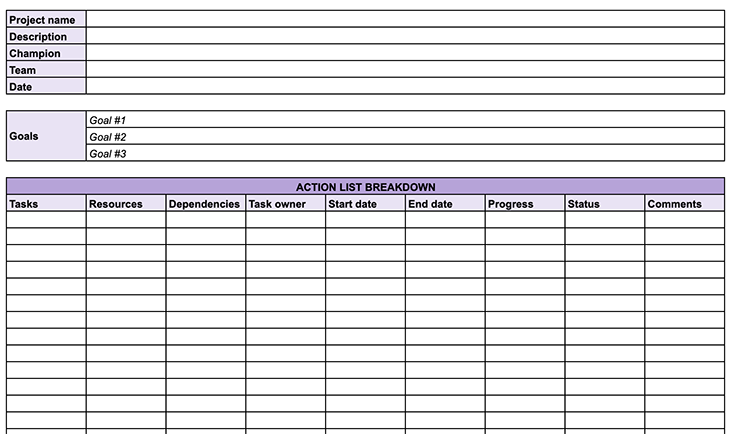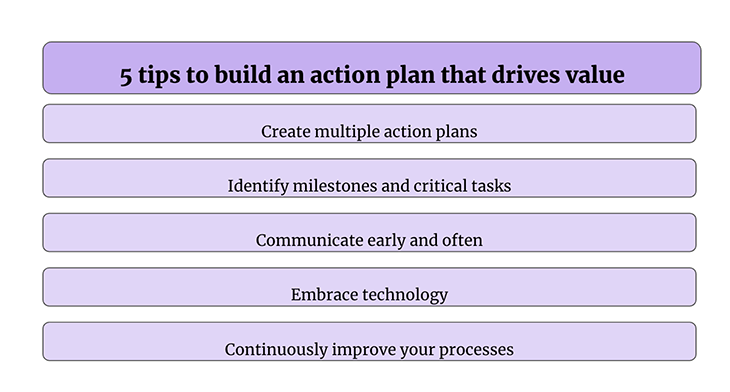Editor’s note: This blog was updated 27 June 2023 to add more information about action plans, including examples of the types of organizations that can use action plans and an in-depth example study. The action plan template was also updated.

Have a thoughtfully laid-out product roadmap? Great! What’s next?
It’s time to make things happen and turn your product vision into reality.
As a product manager, you’re akin to an orchestrator, juggling multiple hats that need different levels of skill and communication — the glue that brings everything together. One of the most important things you need to get started is an action plan.
An action plan is a guiding document and work breakdown structure that outlines all the tasks that need to be completed so you can achieve your product goals.
An action plan is like a music sheet: if you have a defined set of notes, you know exactly what the music is going to sound like.
As the product manager, you need to be able to define the set of tasks in sequential order, considering dependencies and priorities, that will help you complete your project in the quickest, most efficient way possible.
Action plans do not all have to be for complicated products or things — they can be for easy, short-term plans as well. For example, say a product team at a stationery company wants to introduce a new pen model. Their action plan could involve defining the new model’s design, sourcing materials, setting up manufacturing processes, determining marketing strategies, and setting a timeline for the product launch.
Another example could be a clothing brand apparel brand plans to launch a new, sustainable line. This action plan could include researching sustainable materials and manufacturing processes, designing the clothing line, determining pricing strategies, planning the marketing campaign to emphasize the sustainability angle, and coordinating the product launch across various sales channels.
As you can see, action plans don’t always have to be for complex software products. We’ll walk through an example later in the article more suited toward a digital tech product, but the point is that every team can use an action plan no matter what their product is!
It’s important to note that an action plan and product strategy are not the same thing. Product strategy defines the high-level direction of what will make a product successful and a general idea of how to get there. An action plan is created from an execution standpoint and is not meant to define product strategy.
However, a good action plan should incorporate a long-term product strategy that aligns with business goals. Taking action that doesn’t ultimately lead to achieving your goals is simply unnecessary and a drain on your resources. A smart action plan embraces the fact that business goals and product priorities can change along the way, making it crucial to create a plan that is flexible and allows you to pivot with minimal disruptions.
All in all, an action plan (especially when finely tuned and strategic) complements your product strategy by providing an actionable roadmap to success. As mentioned earlier, while the product strategy paints the high-level vision for what will make a product successful, the action plan breaks this down into tactical steps — think of it as the bridge between the strategy and actual implementation. It’s important to clarify that a well-crafted action plan does not aim to redefine the product strategy but gives a path to execute it.
Creating an action plan is a logical exercise, much like putting the pieces of a jigsaw puzzle together. It’s just that sometimes, you don’t have the jigsaw pieces readily available, so you have to do some digging to find them first.
Whether you’re using pen and paper or a more sophisticated project management tool such as Jira or Confluence, it’s important to write down your action plan so you can get everyone on the same page (literally) and reference it later.
The steps to writing an effective action plan are as follows:

The most important step in creating an action plan is to define the goals you want to achieve through that plan. This isn’t exclusively about launching a new product feature or enhancing user experience, you can equally use an action plan to reinforce security measures or diminish your product’s tech debt. The goals can be big or small, but defining them clearly is crucial.
To ensure these goals are robust and measurable, incorporate data metrics as your success indicators and set feasible timelines. The more precise and data-centric your goals, the more actionable they become. For example: Increase net-new users by X percent through the release of Y new feature by the end of Q3.
Now that you have your goals defined, work backward from your goals and think about all the different pieces you need to reach them.
When dealing with so many moving parts, it’s important to create a structure for them. We call this the work breakdown structure.
Essentially, this involves dissecting the project into smaller, manageable tasks. Organize these tasks into groups and create dependencies and communication links between them. This forms the framework you can use to fully build out your action plan.
The framework will help you create a holistic execution plan and force you to think about the things that you possibly could have missed. No two companies are alike, so create a detailed framework that works for you and your company.
Here’s an example of a simple, high-level framework for a process-oriented action plan that’s ideal for software companies:
Product scoping — Gather product requirements through product analytics, customer discovery, cross-functional collaboration and internal feedback, competitive and market trends, and any other source that brings insights into the product you’re building. Consider how your product will impact existing customers, other products, teams, revenue streams, etc. within your company.
Technical scoping — Once you have the product requirements nailed down, having technical scoping discussions helps to understand technical feasibility and dependencies better.
UI/UX design — Create prototypes according to user experience and design best practices. This will help validate technical feasibility, customer usability, and alignment with product strategy.
Development — Now that we have a solid set of requirements that are ready to be developed, you can create further action plans specifically for development in collaboration with your engineering manager(s). Together with your engineering leaders, break down the development phase into manageable chunks of work, taking into account technical dependencies and the sequential order of how the tasks must be developed.
Testing — Once your product is developed, it’s time to test it. Engage a variety of stakeholders to test your product. More feedback means more insights into how customers will perceive and use your product.
Release and review — Releasing a new product feature can be nerve-wracking. Having a release checklist to go with your action plan can be helpful. Think about all the things that need to be put in place before the release, including communicating with other stakeholders (e.g., support, marketing, sales, leadership, etc.). Once you release, review customer feedback to find ways to improve your product.
Once you have your framework, create a detailed list of tasks for each stage. Support each task with a written description of what the task entails and what defines it as completed. Reach out to your team members to help you understand each task better and include any other details that you think are relevant.
Use the framework as a point of reference to manage your resources. Resources can make or break your project, so it’s important to manage them as efficiently as possible.
In collaboration with your engineering manager, establish the team that will be working on the specific project. Define the roles and responsibilities of each team member and make sure everyone understands how they are expected to contribute to the project.
Assign tasks to team members accordingly and help them understand the scope of their tasks. It’s also important to collaboratively set up deadlines for tasks and then hold them accountable to those timelines.
You now have a well-established action plan. You know who is doing what, when, and how it all leads up to achieving the goals of your action plan. But there are always caveats.
For instance, sometimes you make assumptions before validating, or you’re just not aware of something that can become a problem later on. The list of potential nags is literally endless.
To avoid this, communicate your action plan to your core team, management, cross-functional stakeholders, and other team members to gather feedback. Being open to feedback is critical to learning and growing. Incorporating feedback will build your own credibility and will help evolve the process of creating action plans.
The only constant is change. As market trends and business strategies evolve, you have to be ready to pivot. This can put a damper on your well-established action plans.
Acknowledging this and building flexibility into your action plans will help you keep projects on track. Create milestones or checkpoints in your action plans; this will enable you to make informed decisions on how best to pivot when the need arises.
As things change, update your action plan and communicate at the earliest possible to the project team, as well as any other stakeholder that needs to be in the loop.
Let’s walk through a specific (and realistic) example product managers may face — improving user engagement by releasing a new feature. Specifically, let’s say you’re working on a news app and have been seeing declining user engagement recently. You’re not exactly sure why, but think that introducing a personalization feature might increase engagement. Following the steps outlined to create an action plan, the process would look like this:
The primary goal is to increase user engagement by 20 percent over the next two quarters. You’ll do this by introducing a personalization feature that tailors content to the individual user’s interests — something that we believe our competitors are doing already.
This will be measured by tracking metrics such as session duration, number of articles read per session, and click-through rates on personalized content suggestions.
You’ll use the simple, high-level framework we outlined to build the task list.
Product scoping — Conduct market research to understand user preferences for personalized content and see how our competitors are currently doing it.
Technical scoping — Collaborate with the technical team to assess the feasibility of implementing personalization algorithms, dependencies, and any potential challenges. This step may include meetings with data scientists and backend developers.
UI/UX design — Design the user interface for the personalized content feed. It could include the location of the personalized feed on the home screen, a section for users to choose their interests, etc. This step will involve creating wireframes, developing prototypes, and conducting user testing to validate the design.
Development — Implement the personalization feature, including the development of the algorithm, changes to the backend to handle user data securely, and the frontend changes to display personalized content.
Testing — Extensively test the new feature for usability, security, learning curve, etc.
Release and review — Plan the release of the new feature, and consider a soft launch with a small user group to collect early feedback. After the release, continue to collect user feedback to identify any needs for improvement.
For the sake of our example, let’s assume all of the team members have availability to help. The product manager will work on the product scoping phase and coordinate with the technical team for technical scoping, UX designers will handle the UI/UX design phase, developers and data scientists will work on developing the personalization algorithm and integrating it with the app during the development phase, etc.
The plan is then shared with all stakeholders — the core team, senior management, executives, and other teams impacted by this feature. You’ll get their feedback and make the necessary amendments. You’ll also use project management tools to ensure everyone has a clear understanding of the action plan and their roles.
Lastly, you’ll set up regular reviews to monitor progress and make necessary changes in the plan as we encounter new information or challenges.
Now that you have a foundational understanding of what to include in an action plan and how to write one, where do you start?
This action plan template is designed to help you keep track of tasks, resources, dependencies, and progress in a single, easy-to-read, and even easier-to-update spreadsheet:

To customize the action plan template for your next project, click here and select File > Make a copy from the main menu at the top of the page.
A rushed or incomplete action plan will lead to stress and frustration down the road. Here are five best practices to help you create an effective and efficient action plan:

Action plans can get pretty daunting for bigger projects. Don’t overwhelm yourself; use the same concept as the work breakdown structure.
Start by creating a holistic, high-level action plan that encompasses the entire project. Then, take each part of that plan and break it down further, and so on.
You can create individual action plans for each part of the high-level action plan. You may also need to do this for specific parts of the project if they have a lot of dependencies or require many people to collaborate with each other.
When you have numerous tasks, you might have trouble managing them all.
Identifying milestones and critical tasks can bring visibility to the most important parts of the action plan. Make sure you have the right stakeholders in the room when discussing these.
Celebrating milestones is also a great way to improve the morale of the team.
No matter how detailed your action plans are, if you are not able to communicate them properly to the project team, it will be difficult to achieve your goals.
Keep the communication continuously flowing and keep an eye out for blockers. As the product manager, you need to work with the team to remove obstacles and keep things moving along.
Communication also goes a long way to align the team during change management.
Technology can make our lives so much easier when we know how to apply it in the right ways.
There are many software tools that can help you create, document, and manage your action plans. Assess your needs and experiment with free trials to gauge which tool suits your process the best.
If paid software is too far out of the picture at the moment, you can simply use Google Sheets/Docs or Microsoft Excel/Word to create your action plan. Click here for a simple action plan template in Google Docs.
Small things that are done to better the process eventually add up and create drastic efficiencies over time.
Make time for feedback and introspection loops. Find ways to incorporate relevant feedback and distribute the knowledge. Monitor for process patterns and areas that need improvement and discuss with the team how you can make the overall process better for everybody.
Collaborate with the team to make improvements incrementally and continuously.
The framework and process for creating and managing action plans can vary based on the project and team. As long as you have action plans documented and communicate regularly with relevant stakeholders, you will be able to get things done efficiently.
Remember, as the orchestrator (product manager), you need your music sheet (action plan) and your orchestra (project team) to align, and you’ve got yourself a fantastic concert (product)!

LogRocket identifies friction points in the user experience so you can make informed decisions about product and design changes that must happen to hit your goals.
With LogRocket, you can understand the scope of the issues affecting your product and prioritize the changes that need to be made. LogRocket simplifies workflows by allowing Engineering, Product, UX, and Design teams to work from the same data as you, eliminating any confusion about what needs to be done.
Get your teams on the same page — try LogRocket today.

A practical five minute revenue estimation method to help product managers compare ideas, drop low impact features, and prioritize smarter.

A practical guide for PMs who want to stop being bottlenecks, delegate smarter, and lead teams effectively with a clear ownership framework.

Stop letting unreliable data block features. Treat data as inventory to track quality, ownership, and ship with confidence.

Learn why slide decks slow teams down and explore better tools like whiteboards, PRDs, and prototypes to improve collaboration and alignment.